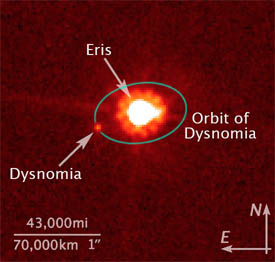
The largest dwarf planet, Eris (center), and its moon, Dysnomia, were observed with the Hubble Space Telescope on Aug. 30, 2006.
NASA/ESA/M. Brown (Caltech)
Back in 2005 Michael E. Brown (Caltech) and his team discovered a large body in the outer regions of the solar system. Initial observations suggested it was larger than Pluto, raising the question: "Is it a planet?" After much hullabaloo, last year the International Astronomical Union ruled that the new body, later dubbed Eris, would — together with slightly smaller Pluto — be known as dwarf planets, a new subclass of planetary bodies.
Now that the smoke has settled, Brown and Emily Schaller (Caltech) have closely studied the Eris system at the Keck Observatory in Hawaii and using the Hubble Space Telescope to determine the orbit of Eris's moon, Dysnomia. Knowing the orbit's radius (37,350 ±140 kilometers) and period (15.774 days), they calculate that Eris has a mass of 1.66 × 1022 kilograms. That's 27% more massive than Pluto, so Eris ranks as both the largest known member of the Kuiper Belt and the most massive dwarf planet.
Writing about their result in the June 15th issue of Science, Brown and Schaller also report that deep Hubble observations rule out any other moons in the system larger than about 50 km (30 miles) across. Details can also be found on Brown's Web page about Dysnomia.
 0
0
Comments
You must be logged in to post a comment.